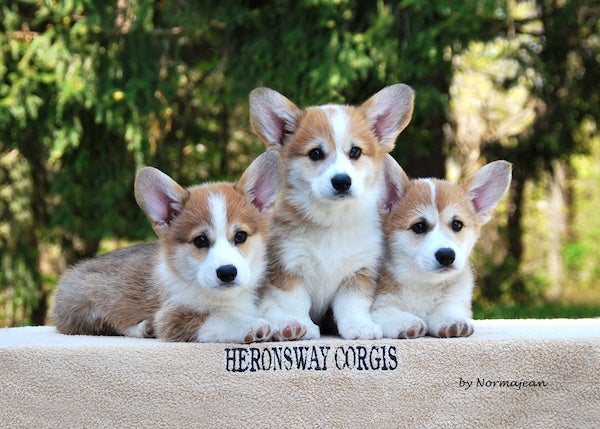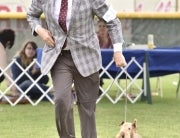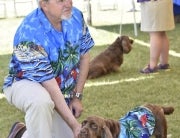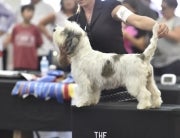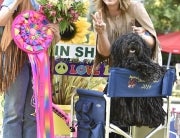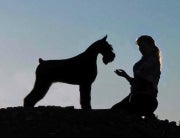This week we spoke with Anne Bowes, of Heronsway Pembroke Welsh Corgis.
- Tell us a little about your personal history: How did you get started in dogs?
I walked onto the grounds of my first dog show purely by accident. I was riding a horse at the Ox Ridge Hunt Club, in Darien, Connecticut, on a Saturday morning in September 1967. When I got there that morning, there were many yellow and white tents set up on the polo field. I asked what was going on, and I was told that the Ox Ridge Kennel Club was having its annual dog show that day. I didn’t even know they showed dogs!
After I rode my horse, I walked onto the grounds of that dog show and into the rest of my life! I knew then and there that I wanted to raise, train, and show dogs.
- Why did you decide to handle your dog yourself?
I wanted to learn everything I could about showing and breeding dogs, and I wanted to do it all myself. I thought at the time that if you had someone else show your dog for you, it would be like playing golf and having someone else hit the shots. And to be honest, I couldn’t afford to show dogs any other way—so I had to learn how to do it myself!
- How much do you work with a dog at home before handling him or her at shows?
I only show dogs that I raise myself—I plan the breeding, I own the mother (and sometimes the father), they are born into my hands, and I raise, train, and show them. So, I start their show training when they are 4 weeks old and can just barely stand on a table. And the process is ongoing—many, many handling classes and training sessions at home happen before the puppy is ready for the ring.
Before a big show like the National Championship, Westminster, or the Pembroke Welsh Corgi Club of America national specialty, I work constantly with the dogs who have been entered. More classes and lots of practice at home. I have a training area set up at my home that has mats, mirrors, tables, and ring gates so I can pretty much duplicate what my dogs will encounter in the ring.
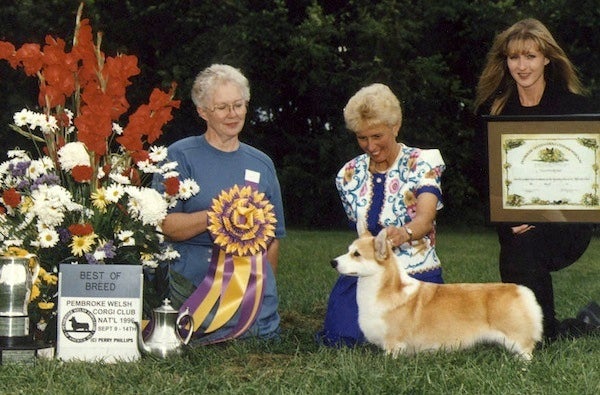
Breeder-owner-handled Ch. Vahalla Heronsway Crystal winning Best of Breed at the 1996 Pembroke Welsh Corgi Club of America national specialty show under judge Janice Edwards.
- What is your strategy on the use (or not) of bait?
Pembroke Welsh Corgis are a “free-stacked” breed—in other words, I need to train them to do everything on their own. They need to learn to “stack” themselves on the ground. I do this by the use of bait. Also, my breed is shown on a table. Once I get them on the table and stacked for the judge, I use bait to get them to stretch up their neck and use their ears. I cannot show my dogs without bait. If I encounter a judge who proclaims that they do not want bait used in their ring, I most likely will not show to that judge again.
- Do you get pre-ring jitters? If so, how do you deal with them?
I have been showing dogs at an average of 40 shows a year for 46 years, and I have been judging dog shows for 26 years. I feel very much at home in the dog show ring, and I do not get nervous—excited for sure, but not nervous. For those who do get “pre-ring jitters,” I recommend that you get lots of handling class practice, take something to calm your stomach, and chew a mint!
- What do you find to be the major benefits of showing your own dog?
While there are many benefits to showing your own dog, the one I love the most is the relationship I have with each dog I show. All the hours of training, conditioning, grooming, and traveling together to the shows develops a strong bond between my dogs and me that is very special to me.

Breeder-owner-handled GCh. Heronsway Comedy Central winning Best of Breed at the 2016 Westminster Kennel Club show under judge Peggy Beisel-McIlwaine.
- What kind of things have you learned from observing good handlers?
When I first started showing, I watched professional handlers and junior handlers show their dogs to learn how to do it. I particularly watched handlers of toy dogs, because all toys are shown on a table, as are Pembroke Welsh Corgis. (In the process of watching many, many Toy Groups, I fell in love with toy dogs!) I still watch outstanding handlers in the group ring and pick up pointers from them. I try out everything I think has merit—some things work for me, and some don’t.
- What are the biggest mistakes that you see new owner-handlers making?
One of the biggest mistakes new owner-handlers make is to blame their losses on politics, professional handlers, or the judges—on everything but the dog at the end of their lead and their ability to handle that dog. If a person does not realize they have to work hard at learning how to show dogs, I know they will be gone from the sport in a few months!
Many beginners start out with a dog who most likely is not a show prospect. I know I did; my first dog was not capable of winning a championship. And most beginners have no concept of how hard it is to learn to show any dog competitively.
I have heard new handlers (especially those who come from companion and performance events) ask, “How hard can it be to teach a dog to stand around and look at a piece of bait?” To which I always answer, “MUCH harder than it looks!” It takes years of practice to compete in the ring successfully with professional handlers who work with dogs every day of their life. Dog showing is the only sport I know of where professionals and amateurs compete head to head.
So if you are just starting out in this sport, be patient, and keep practicing and learning. And make sure you have a competitive dog to show!

Breeder-owner-handled GCh. Heronsway Capriccio winning Owner-Handled Best in Show at Wachusett Kennel Club under judge Robert Indeglia in August 2015.
- What are interesting ring quirks of some of the dogs you’ve shown?
Each dog is different, which makes dog showing so fascinating and difficult at the same time. If every dog were the same, there would be no challenge!
Some dogs are just natural show dogs and do everything easily, but others can decide that the judge is very “suspicious,” or that a dog or person standing ringside needs to be avoided.
I showed a dog who always laid down when I attempted to set his rear legs on the table, and another who would never gait toward a solid wall! Some dogs show better outdoors, and some show better indoors. Knowing the strengths and weaknesses of the dog you are showing is one of the keys to success in the ring.
- Who was the most difficult dog you have shown, and how did you handle that challenge?
I once showed a dog who freaked out every time someone came near her with a camera, even though she had never had a bad experience with a camera that I knew of. So I spent time with her at the photographer’s setup at every show we went to. I talked the photographers into working with me and offering her treats. Eventually, she associated cameras with food and got over her fear.
- Can you share with us a memorable moment, either amusing or embarrassing, that you have had as an owner-handler?
I once showed two bitches in a very large entry. The first one was a puppy shown in the 9–12 puppy class. The second was in the Bred-by-Exhibitor class, and she was in season, so I mentioned that to the judge as he was going over her. The judge asked, “Are you going to breed her this time?” I said, “I would like to finish her championship first.” To which the judge replied, “Not today!” I took that to mean that he preferred my puppy bitch to my Bred-by bitch, and I quickly decided that I should take the puppy back into Winners and hand off my Bred-by bitch to someone else—which was a change from my original plan. It worked well, and the puppy won a huge major that day!
- What is one of your most proud moments as an owner-handler?
I have had many proud moments in the ring with my dogs over the past 46 years. That is what is so wonderful about showing your own dogs—when the judge points to your dog for Winners or Best of Breed, it is the most fantastic feeling in the world! I cannot say that I have tried all the “highs” out there, but I can say that of those I have tried, nothing beats winning with a dog you have held in your hand at birth, whose breeding you planned yourself, and whom you have raised, trained, and handled yourself to that special win.
Of all the wins I have had, I have to say that winning Best of Breed breeder-owner-handled at both the Pembroke Welsh Corgi Club of America national specialty show and at Westminster have to be two of my proudest moments ever.
Also, of course, winning the Herding Group AKC Breeder of the Year award in 2007 was a huge honor. That was a BIG achievement for an owner-handler!
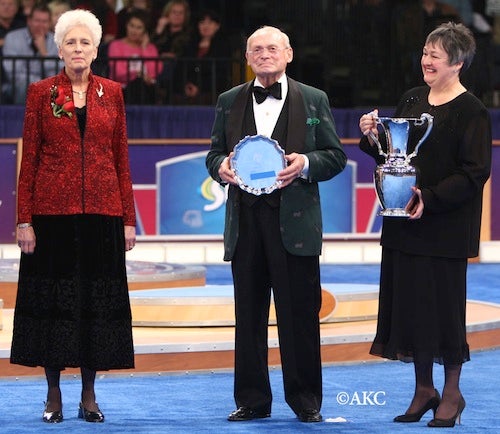
Receiving the Herding Group AKC Breeder of the Year Award for 2007, with presenters Walter Goodman and Patti Strand.
- What advice would you offer newcomers who are interested in handling their own dog in shows?
Newcomers to the sport often leave the show as soon as they are finished with their class (which they most often lose!). My advice is to stay for the whole day—watch the rest of your breed after your class is finished. Watch the dog who wins Best of Breed compete in the group. Watch the junior handlers and other professional handlers show dogs of your breed, or breeds similar to yours.
Talk to the experienced handlers, and ask questions—and listen to what they tell you. The dog show is a wealth of information about how to handle your dog, free for the taking. Then take what you have learned at the dog show to handling class, and PRACTICE, PRACTICE, PRACTICE!
Thank you very much, Anne, for taking the time to share your comments.
Photos courtesy Anne Bowes
VIDEO: Hear Anne’s advice on early puppy training, from the AKC Breeder-to-Breeder Symposium.


